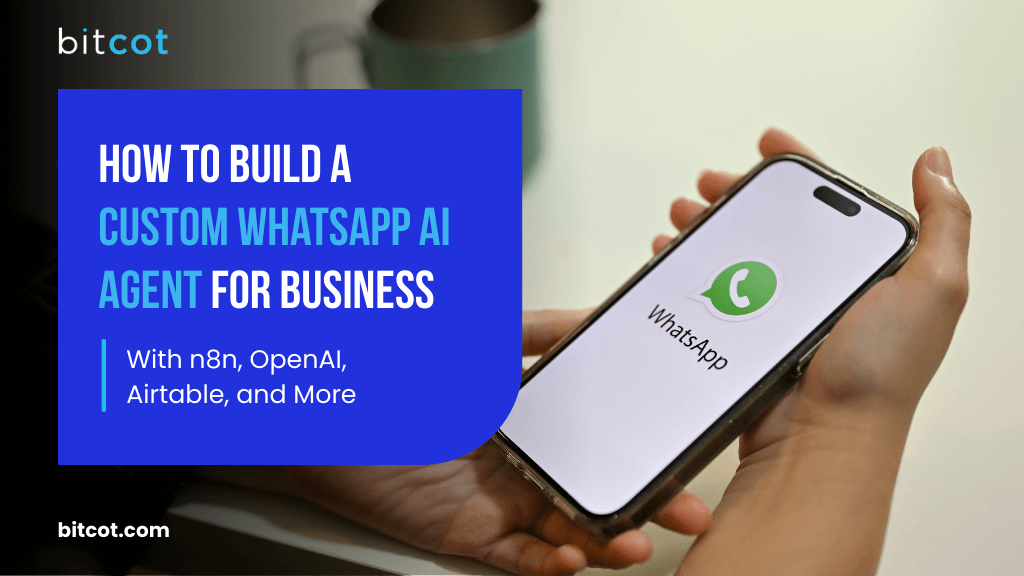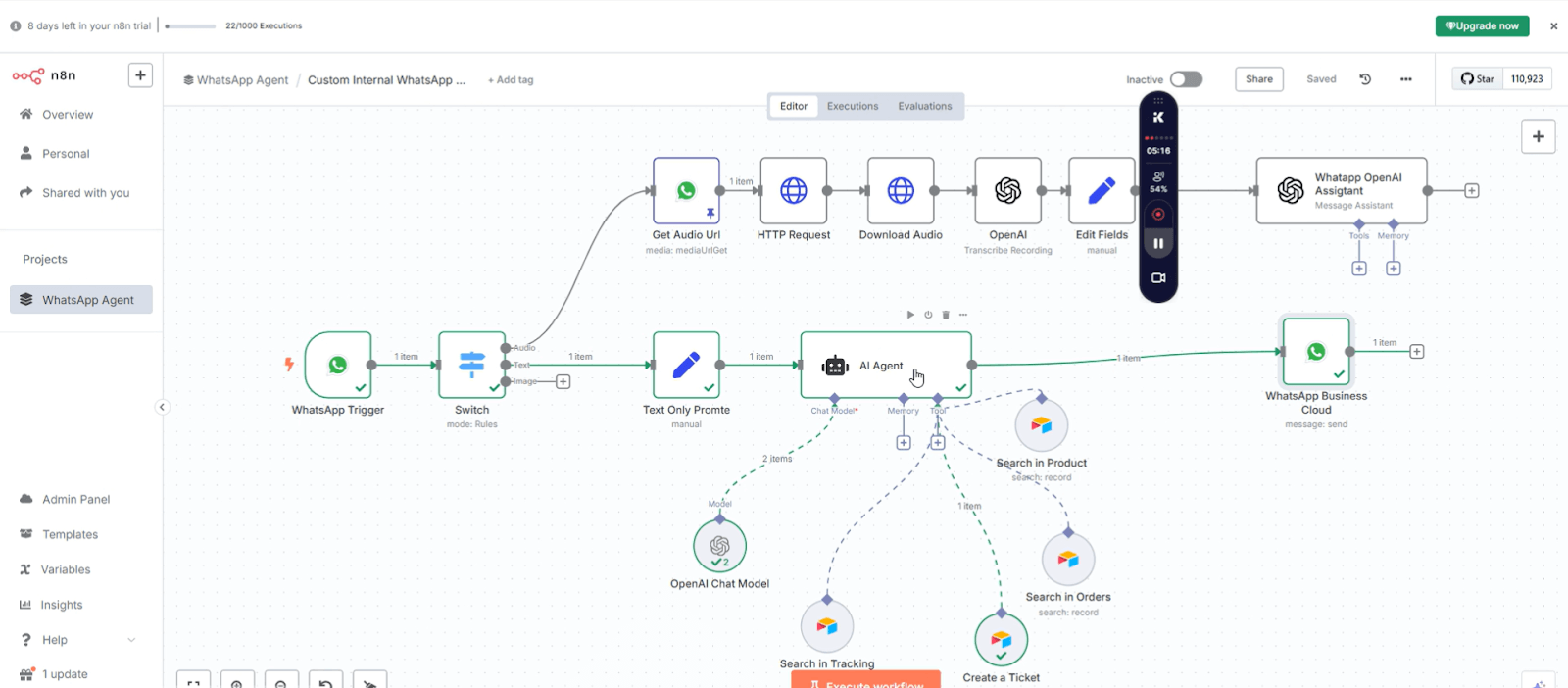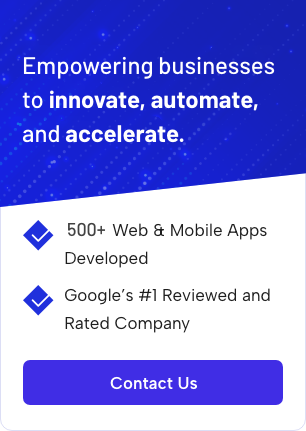
“Hi! Reply 1 for products, 2 for orders, 3 for support.”
“Hey there👋 Looking for something specific? I can help you track your order, check product prices, or even raise a support ticket. Just tell me what you need.”
Now ask yourself, which one would your customers prefer?
Obviously, the second one. It feels natural. It feels human. And it actually helps.
Simple WhatsApp automation can’t do this.
We thought: what if it could be better? What if a WhatsApp bot could understand, not just respond?
So we built it.
A powerful WhatsApp AI agent n8n workflow that doesn’t just automate responses but understands intent, pulls live data, transcribes voice notes, reads PDFs, and even schedules your next Zoom call.
By integrating cutting-edge AI with structured databases and workflows, this system delights your customers with that kind of intelligent, personalized experience.
In this article, we’re going to walk you through the PoC solution we built, break down how it works, and show you what happens when chatting with a bot on WhatsApp actually feels like a conversation.
Bitcot’s WhatsApp n8n Agent Solution
As Business Insider reported last month, WhatsApp is quietly becoming one of the most active platforms for how people interact with AI, with major players like OpenAI and Perplexity launching their chatbots directly inside the app.
That’s not surprising… it’s where 100 million users in the US already spend their time each month.
For businesses, this is a goldmine opportunity.
WhatsApp offers a massive surface for building AI-powered experiences that handle real customer needs in a channel they already trust.
While companies like OpenAI are bringing their general-purpose chatbots to WhatsApp, businesses like yours are now leveraging the same platform to build task-specific AI agents.
At Bitcot, we designed our PoC system for WhatsApp OpenAI chatbot integration from the ground up to transform WhatsApp into your most powerful sales and support channel. Our approach is significantly more customizable and sophisticated than traditional bots that rely on static options.
To get started, we used Twilio, an official WhatsApp Business Solution Provider (BSP), to obtain WhatsApp Business API access. Alternatively, you can also use WhatsApp Cloud API directly from Meta, depending on technical preferences and pricing models.
Twilio enables us to:
- Register a verified WhatsApp business number
- Connect webhook endpoints to our backend workflows
- Send and receive real-time messages through programmable interfaces
Setting up a reliable messaging system for your WhatsApp business AI agent requires more than just API access. You need a robust orchestration layer to:
- Receive incoming messages via webhook
- Process intent using AI or rules
- Query backend systems (orders, inventory, tickets)
- Format and send contextual replies
- Log interactions for monitoring and analytics
While some businesses rely on plug-and-play SaaS tools like WATI or Zoko, these lack flexibility for advanced logic or custom API integrations.
That’s the gap our n8n WhatsApp chatbot fills. n8n is a powerful open-source workflow engine that allows us to quickly build WhatsApp AI agent solutions and control messaging flows end-to-end.
It gives us full flexibility to design, trigger, and manage OpenAI WhatsApp chat conversations, whether it’s responding to customer queries, connecting to external systems, or handling complex logic without writing heavy code.
With an n8n WhatsApp workflow, we were able to:
- Handle branching logic visually
- Integrate with Airtable, OpenAI, Google Calendar, Gmail, and more
- Modify workflows in real-time without extensive redeployment
This is a custom-built, yet low-code implementation, ideal for businesses that want full control without deep engineering overhead. It’s a fully integrated and sophisticated orchestration system. You have complete visibility and control over how data moves, how workflows are triggered, and how responses are generated.
We’ve built this WhatsApp n8n agent using a modern, modular tech stack designed for flexibility, scalability, and customization. See the stack breakdown below:
| Layer | PoC Tech Stack | Description |
| Chat Transport | WhatsApp API (Twilio or Cloud API) | Handles sending and receiving messages over WhatsApp via official APIs. |
| Workflow Engine | n8n | Automates and orchestrates the flow of tasks and data between different services. |
| Language Generation | OpenAI GPT | Generates natural language responses. |
| Database | Airtable | Stores and manages structured data used in workflows and responses. |
| Audio Processing (optional) | Whisper API / Google STT | Converts voice/audio inputs into text for further processing. |
| Image & PDF Processing (optional) | OpenAI Vision, PyMuPDF | Extracts and analyzes content from images and PDF documents. |
| Scheduling (optional) | Google Calendar, Zoom API | Manages event scheduling and video call setups. |
| Email Handling (optional) | Gmail API or Microsoft Graph API | Sends, receives, and processes emails programmatically. |
The Workflow Behind Our Custom AI WhatsApp Chatbot

Now, we’ll walk you through the AI WhatsApp chatbot flow that processes incoming WhatsApp messages, understands them with OpenAI, searches your database, and responds instantly.
Step 1: Triggering on Incoming WhatsApp Messages
Everything starts with a WhatsApp Trigger node. This listens for any new messages your business receives over WhatsApp.
Whenever a customer sends a message, whether it’s text, audio, or an image, this trigger captures all the details and hands them off to the next step.
Step 2: Determining the Message Type
This decision-making step checks the content type:
- Audio (voice note)
- Text
- Image
Depending on the type, the message is routed down a different branch of the workflow. This ensures each message is processed correctly.
Step 3: Processing Text Messages and Analyzing Intent
The n8n WhatsApp AI agent is the “brain” of this OpenAI WhatsApp integration. It receives the incoming text and determines:
- Is this a general question?
- Is this about a product?
- Is this about an order?
- Does it need ticket creation?
Step 4: Data Routing via Airtable
All business-critical data is stored and managed in Airtable. Depending on intent, the message is routed to the relevant Airtable-connected module:
- Product Table: Users can ask about products using various identifiers, such as product name, product code, or price.

- Order Table: The AI agent can fetch order information using order numbers or customer names.

- Tracking Table: The AI agent can provide up-to-date shipping status.

- Support Ticket Table: Users can create support tickets directly from conversations. Each request adds a new row in the Support Ticket table, containing customer information, order number, and issue description.

Step 5: Gathering Data and Generating a Natural AI Response
If any searches or tickets were done, the AI agent collects the response data (e.g., order status or ticket confirmation).
The agent then combines this information into a cohesive prompt, which includes:
- The user’s original message
- Any relevant search results
- Any context from the conversation memory
This combined data is then sent to the OpenAI Chat Model. The model processes all of this input to craft a response that feels natural, conversational, and appropriate to the user’s request. The AI agent receives this friendly, human-like response.
Step 6: Delivering the Final Reply via WhatsApp

The next step is ensuring the response reaches the user.
The AI-generated reply is sent directly to the WhatsApp Business Cloud node, which is configured to:
- Deliver the message to the same user who sent the original text
- Use WhatsApp’s official Business API to send a real-time reply
This is where the customer sees the bot’s message in their WhatsApp chat.
At this point, it’s basically like ChatGPT on WhatsApp: smart, instant, and right there in your users’ WhatsApp AI chat window.
A WhatsApp AI agent GPT-4o integration is just one example of how this can work. In reality, businesses create custom WhatsApp chatbot solutions using a variety of powerful models and platforms.
The most common are OpenAI’s GPT-3.5 and GPT-4 models, which deliver advanced natural language understanding and generation.
Others rely on Google Dialogflow, which offers a user-friendly platform backed by Google’s NLP technology to design conversational flows. Some prefer open-source frameworks like Rasa, which allow for full customization and control over the AI’s behavior.
Whatever your choice, the key is connecting that intelligence seamlessly to WhatsApp, enabling real-time, natural conversations that feel effortless for your customers.
Upcoming Enhancements in Our AI Chatbot for WhatsApp
Our current OpenAI WhatsApp chatbot already handles customer interactions with the kind of automated efficiency that would make a mid-century management consultant weep with joy, but we’re not going to stop at “good enough.”
There’s always another layer of automation to add, another human process to optimize, another opportunity to replace messy, inefficient human contact.
Forget what you think an AI chatbot for WhatsApp can do. As our n8n WhatsApp bot evolves, several exciting features are in the pipeline to enhance user interaction, enrich conversations, and transform what we mean by “customer service” in 2025.
Audio Chat Integration
- Voice Message Support: Users will be able to send voice messages directly to the AI agent, allowing for more natural, hands-free conversations. This feature caters to users who prefer speaking over typing, making interactions more intuitive.
- Speech-to-Text Conversion: Once a voice message is received, the AI agent uses technologies like the Whisper API or Google Speech-to-Text (STT) to convert the spoken words into text. This ensures that the AI understands the user’s request accurately, even if it’s in an informal, spoken tone.
- Seamless Interaction: What’s cool is how natural this feels. People send voice messages all the time on WhatsApp, and we’re just making the bot smart enough to understand the nuances of voice and context. It listens, processes, and replies in real-time, creating a conversation that feels as natural as talking to a person.
Image Recognition + Visual Q&A
- Product Image Uploads: Users will be able to send product images through WhatsApp, and the AI agent will automatically analyze the image using OpenAI Vision, a powerful image recognition tool.
- AI-Powered Image Analysis: The AI will not only recognize the product but also offer relevant insights based on the visual data. Whether it’s identifying the product, comparing it to others, or providing additional context, the AI agent ensures that users get precise, context-aware answers.
- Use Case: “Do you have something similar?” with a competitor’s product image attached actually works now. The vision models got good enough that this isn’t a party trick anymore. The AI agent will analyze the image, compare it with your product catalog, and instantly suggest similar items.
PDF Summarization & Data Extraction
- PDF Upload Functionality: Users will be able to upload PDFs, such as invoices, receipts, or purchase orders, directly into the WhatsApp chat.
- Advanced Data Processing: Once the PDF is uploaded, tools like PyMuPDF and OpenAI will be used to summarize the content and extract key data points. This eliminates the need for users to manually sift through pages of text.
- Use Case: “What’s covered under my warranty?” becomes a query the system can answer instantly by analyzing the uploaded document.
Meeting Scheduling & Calendar Sync
- Google Calendar & Zoom Integration: The AI agent can integrate directly with Google Calendar and Zoom APIs, allowing users to schedule meetings, receive reminders, and get real-time updates within WhatsApp.
- Instant Scheduling: “I need to schedule a consultation for next Tuesday” results in “Available slots: 10 AM, 2 PM, 4 PM. Which works for you?”
Email Integration for Seamless Communication
- Direct Email Sending: The AI agent allows users to send emails directly from WhatsApp. By issuing simple voice or text commands, users can specify the subject, body, and recipient, and the AI agent will handle the email composition and send it using integrated email platforms like Gmail and Microsoft Graph API.
- Reading & Responding to Emails: The AI agent will not only be able to send emails but also read incoming ones. This makes it possible for users to manage their inbox directly from WhatsApp, without needing to toggle between multiple apps.
- Use Case: If a customer wants to leave feedback, they can simply say, “Can you send an email to feedback@yourstore.com saying this coffee maker is great, and thanks for the fast shipping?” The AI agent processes the request, sends the email, and confirms it’s done.
Benefits of Building WhatsApp AI Agents Using n8n
There’s something almost perverse about how excited we get about workflow automation, but n8n makes building full-stack conversational assistants feel incredibly easy.
The main advantage isn’t just the drag-and-drop interface (though that certainly helps when explaining to stakeholders why connecting WhatsApp, OpenAI, and your CRM doesn’t need six months of work).
It’s this shift from “building integrations” to “connecting workflows”.
When you can literally see the data flowing from one step to the next, suddenly that complex multi-step process becomes intuitive. You’re not writing API calls anymore, you’re drawing a map of how information should move.
But that’s not the revolutionary part. The revolutionary part is that with n8n, you can build what might charitably be called the next generation of business communication tools.
And once you start thinking in workflows rather than individual automations, you realize the potential goes way beyond chatbots.
Take something like appointment scheduling. We built out this automated reminder system using n8n and DynamoDB that handles everything from initial booking confirmations to follow-up sequences. Same visual workflow approach, but now you’re orchestrating entire customer journeys rather than just responding to messages.
The point is this: n8n enables you to think bigger and automate smarter. When you can prototype a complex workflow in an afternoon and have it running in production by the end of the week, you start looking for the highest-impact places to deploy that speed. And WhatsApp AI agents are probably at the top of that list.
Here’s why you should create WhatsApp AI agents using n8n:
Superior Flexibility and Customization
Unlike rigid SaaS solutions like WATI, n8n WhatsApp automation delivers complete customization freedom. You can design sophisticated branching logic, create complex conditional workflows, and integrate with virtually any external system your business relies on. This means pure flexibility to build exactly what your customers need.
Seamless Multi-Modal Communication
This solution handles every type of WhatsApp message format effortlessly. Whether customers send text messages, voice notes, images, or documents, the AI agent processes each input type intelligently. This means the AI gets complete context immediately instead of requiring multiple back-and-forth text exchanges.
Real-Time Business Intelligence Integration
Through direct integration with your existing business systems via Airtable and custom APIs, the AI agent provides instant access to live data. Customers can check order status, inventory levels, support ticket progress, and product information in real-time. This eliminates the frustration of outdated information and reduces your workload.
Advanced Natural Language Processing
Powered by OpenAI’s GPT models, the solution delivers conversational experiences that feel genuinely human. It understands context, maintains conversation memory, and generates responses that are both accurate and naturally worded. This creates a premium experience that builds trust and reflects your brand professionally.
Context-Aware Conversations
If the customer asks multiple follow-up questions or needs clarification, a basic chatbot might struggle. If a customer wants to know why their order is delayed, the bot might provide a generic answer like “Your order is in progress.” But an AI agent can instantly provide the current status and follow up with more granular details.
Cost-Effective Scalability
Whether you’re handling dozens or thousands of daily conversations, the architecture adapts without requiring significant infrastructure investments. The combination of automated responses for routine inquiries and intelligent routing for complex issues optimizes your support resources while maintaining service quality.
| Aspect | Bitcot’s PoC Solution | SaaS Tools |
| Flexibility | Fully customizable via n8n + APIs | Pre-built features, less customization |
| AI Capabilities | OpenAI GPT replies, image & PDF Q&A | Mostly rule-based or basic NLP |
| Data Storage | Airtable as your own backend | Data stored in SaaS CRM |
| Extensibility | Audio, email, meetings, all in one workflow | Usually separate integrations |
| Cost | Lower monthly fees (just API usage & infra) | SaaS subscription fees per seat/volume |
Final Thoughts
To truly create a conversational experience that feels natural and valuable, you need more than buttons.
You need context. You need intelligence. You need flexibility.
In other words, you need AI for WhatsApp to deliver instant, meaningful, and personalized conversations.
Bitcot’s n8n-based AI chatbot WhatsApp solution is that leap forward in customer communication. This kind of WhatsApp artificial intelligence transforms every interaction into an opportunity to build stronger customer relationships.
We’re at this really interesting moment where conversational AI is about to get dramatically better. As new features roll out, our WhatsApp AI bot is set to become a full-fledged, enterprise-grade conversational assistant.
Curious to learn how to create a WhatsApp AI chatbot for your business similar to our PoC?
As a trusted AI agent development company, we’ve helped businesses craft custom AI agents using n8n time and time again.
Get in touch with our team.




















